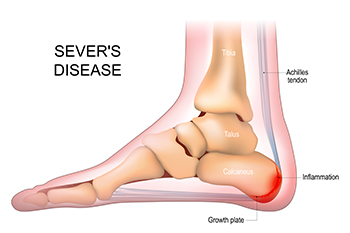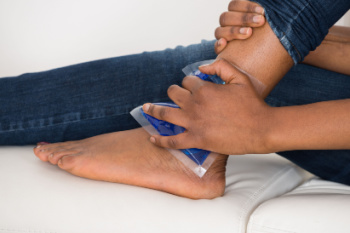
Plantar fasciitis is a common source of heel and arch pain that develops when the thick band of tissue along the bottom of the foot becomes irritated. It may look normal on the surface, yet the foot can feel stiff, tender, or sharp with pain that is most noticeable during the first steps in the morning or after periods of rest. Symptoms include aching in the heel, tightness through the arch, and discomfort that increases with prolonged standing or activity. Causes may involve overuse, wearing unsupportive footwear, high or low arches, or sudden increases in exercise. A podiatrist can begin by evaluating your foot structure, checking for inflammation, and identifying related biomechanical issues. Once diagnosed, treatment may include stretching programs, footwear guidance, custom orthotics, or targeted interventions to reduce strain on the plantar fascia. Because early attention can ease pain and prevent long-term problems, it is suggested that you schedule an appointment with a podiatrist for effective relief and treatment solutions.
Plantar fasciitis can be very painful and inconvenient. If you are experiencing heel pain or symptoms of plantar fasciitis, contact one of our podiatrists from The Foot Specialists. Our doctors can provide the care you need to keep you pain-free and on your feet.
What Is Plantar Fasciitis?
Plantar fasciitis is the inflammation of the thick band of tissue that runs along the bottom of your foot, known as the plantar fascia, and causes mild to severe heel pain.
What Causes Plantar Fasciitis?
- Excessive running
- Non-supportive shoes
- Overpronation
- Repeated stretching and tearing of the plantar fascia
How Can It Be Treated?
- Conservative measures – anti-inflammatories, ice packs, stretching exercises, physical therapy, orthotic devices
- Shockwave therapy – sound waves are sent to the affected area to facilitate healing and are usually used for chronic cases of plantar fasciitis
- Surgery – usually only used as a last resort when all else fails. The plantar fascia can be surgically detached from the heel
While very treatable, plantar fasciitis is definitely not something that should be ignored. Especially in severe cases, speaking to your doctor right away is highly recommended to avoid complications and severe heel pain. Your podiatrist can work with you to provide the appropriate treatment options tailored to your condition.
If you have any questions, please feel free to contact our offices located in Waltham and Milford, MA . We offer the newest diagnostic and treatment technologies for all your foot care needs.

Sever’s disease, a common cause of heel pain in children, occurs when the growth plate at the back of the heel becomes irritated during development. It most often affects active children and adolescents who participate in running and jumping activities. Risk factors include rapid growth, tight calf muscles, flat feet, high arches, and sports that place repeated stress on the heel. Symptoms include heel pain during activity, limping, tenderness when the heel is squeezed, and stiffness after exercise. A podiatrist can evaluate the feet, recommend activity changes, provide heel support, and guide stretching routines that reduce discomfort. If your active child has heel pain, it is suggested that you schedule a visit with a podiatrist who can accurately diagnose and offer relief solutions for Sever’s disease.
Sever's disease often occurs in children and teens. If your child is experiencing foot or ankle pain, see one of our podiatrists from The Foot Specialists. Our doctors can treat your child’s foot and ankle needs.
Sever’s Disease
Sever’s disease is also known as calcaneal apophysitis, which is a medical condition that causes heel pain I none or both feet. The disease is known to affect children between the ages of 8 and 14.
Sever’s disease occurs when part of the child’s heel known as the growth plate (calcaneal epiphysis) is attached to the Achilles tendon. This area can suffer injury when the muscles and tendons of the growing foot do not keep pace with bone growth. Therefore, the constant pain which one experiences at the back of the heel will make the child unable to put any weight on the heel. The child is then forced to walk on their toes.
Symptoms
Acute pain – Pain associated with Sever’s disease is usually felt in the heel when the child engages in physical activity such as walking, jumping and or running.
Highly active – Children who are very active are among the most susceptible in experiencing Sever’s disease, because of the stress and tension placed on their feet.
If you have any questions, please feel free to contact our offices located in Waltham and Milford, MA . We offer the newest diagnostic and treatment technologies for all your foot care needs.

A dislocated ankle occurs when the talus, the main ankle bone, is pushed out of place from under the tibia and fibula, which are the bones of the lower leg. This sudden shift causes sharp pain, swelling, and a foot that looks out of alignment. The injury also affects the ligaments that hold the ankle steady, as well as nearby joints where the talus meets the calcaneus, or heel bone. A podiatrist can check the position of the foot, make sure blood flow and feeling in the toes are normal, and use imaging to see if any nearby bones have been damaged. Treatment focuses on gently guiding the talus back into place and keeping the ankle immobile so healing can start. Surgery may be considered when there are fractures or if the ankle remains unstable. If you believe you have dislocated your ankle, it is suggested that you make an appointment with a podiatrist for a diagnosis and treatment options.
Ankle pain can have many different causes and the pain may potentially be serious. If you have ankle pain, consult with one of our podiatrists from The Foot Specialists. Our doctors will assess your condition and provide you with quality foot and ankle treatment.
Ankle pain is any condition that causes pain in the ankle. Due to the fact that the ankle consists of tendons, muscles, bones, and ligaments, ankle pain can come from a number of different conditions.
Causes
The most common causes of ankle pain include:
- Types of arthritis (rheumatoid, osteoarthritis, and gout)
- Ankle sprains
- Broken ankles
- Achilles tendinitis
- Achilles tendon rupture
- Stress fractures
- Tarsal tunnel syndrome
- Plantar fasciitis
Symptoms
Symptoms of ankle injury vary based upon the condition. Pain may include general pain and discomfort, swelling, aching, redness, bruising, burning or stabbing sensations, and/or loss of sensation.
Diagnosis
Due to the wide variety of potential causes of ankle pain, podiatrists will utilize a number of different methods to properly diagnose ankle pain. This can include asking for personal and family medical histories and of any recent injuries. Further diagnosis may include sensation tests, a physical examination, and potentially x-rays or other imaging tests.
Treatment
Just as the range of causes varies widely, so do treatments. Some more common treatments are rest, ice packs, keeping pressure off the foot, orthotics and braces, medication for inflammation and pain, and surgery.
If you have any questions please feel free to contact our offices located in Waltham and Milford, MA . We offer the newest diagnostic tools and technology to treat your foot and ankle needs.

